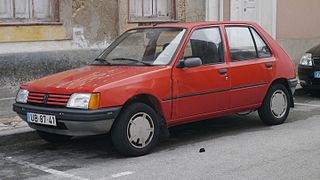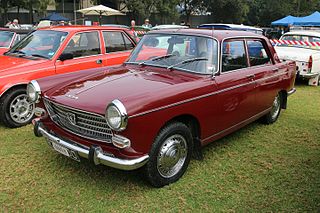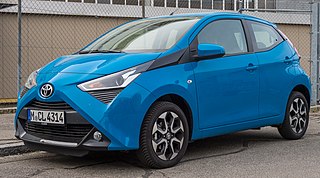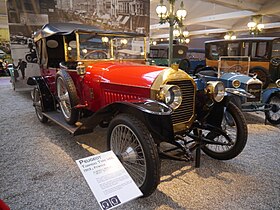
Peugeot is a French brand of automobiles owned by Stellantis.

The Citroën SM is a high-performance coupé produced by the French manufacturer Citroën from 1970 to 1975. The SM placed third in the 1971 European Car of the Year contest, trailing its stablemate Citroën GS, and won the 1972 Motor Trend Car of the Year award in the U.S.

The Peugeot 205 is a supermini (B-segment) car produced by the French manufacturer Peugeot from 1983 to 1998.

The Citroën AX is a supermini which was built by the French manufacturer Citroën from 1986 to 1998. It was launched at the 1986 Paris Motor Show to replace the Citroën Visa and Citroën LNA.

The Peugeot 504 is a mid-size, front-engine, rear-wheel-drive automobile manufactured and marketed by Peugeot from 1968 to 1983 over a single generation, primarily in four-door sedan and wagon configurations – but also as twin two-door coupé and cabriolet configurations as well as pickup truck variants.

The Citroën CX is a large, front-engined, front-wheel-drive executive car manufactured and marketed by Citroën from 1974 to 1991. Production models took the form of a four-door fastback sedan, station wagon (estate), and a long-wheelbase fastback limousine. The CX is known for its hydropneumatic self-leveling suspension system, and its low coefficient of drag, underscored by its nameplate CX, which references the aerodynamics symbol for drag coefficient.

The Citroën BX is a large family car which was produced by the French manufacturer Citroën from 1982 to 1994. In total, 2,315,739 BXs were built during its 12-year history. The hatchback was discontinued in 1993 with the arrival of the Xantia, but the estate continued for another year. The BX was designed to be lightweight, using particularly few body parts, including many made from plastics.

The Citroën LN (Hélène) and Citroën LNA (Hélèna) are front-engine, front-drive, three-door, four passenger hatchback city cars manufactured and marketed by Citroën from 1976-1986 over a single generation — as a badge engineered variant of the Peugeot 104, introduced shortly after the takeover of Citroen by Peugeot.

The Peugeot 206 is a supermini car (B-segment) developed and produced by the French car manufacturer Peugeot since May 1998 as a replacement to the Peugeot 205. Developed under the codename T1, it was released in September 1998 in hatchback form, which was followed by coupé cabriolet in September 2000, station wagon in September 2001, and a sedan version in September 2005.

The Peugeot 404 is a large family car produced by French automobile manufacturer Peugeot from 1960 to 1975. A truck body style variant was marketed until 1988. Styled by Pininfarina, the 404 was offered initially as a saloon, estate, and pickup. A convertible was added in 1962, and a coupé in 1963. The 404 was fitted with a 1.6 litre petrol engine, with either a Solex carburetor or Kugelfischer mechanical fuel injection or a 1.9 litre diesel engine available as options. Introduced at the Paris Motor Show as an option was the inclusion of a 3-speed ZF automatic transmission, similar to the unit already offered on certain BMW models, as an alternative to the standard column-mounted manual unit.

Delage was a French luxury automobile and racecar company founded in 1905 by Louis Delâge in Levallois-Perret near Paris; it was acquired by Delahaye in 1935 and ceased operation in 1953.

The Toyota Aygo is a city car (A-segment) sold by Toyota in Europe since 2005. It is built alongside the related Citroën C1 and Peugeot 107/108 at the Toyota Peugeot Citroën Automobile Czech (TPCA) joint venture in Kolín, Czech Republic. The Aygo was first displayed at the 2005 Salon de l'Automobile Genève. The name "Aygo" comes from "i-go", symbolising freedom and mobility.

The Peugeot 208 is a supermini car produced by the PSA Group, later Stellantis. It was unveiled at the Geneva Motor Show in March 2012. The 208 replaced the 207 in April 2012, and the car is currently at its second generation.

The Peugeot 201 is a car produced by Peugeot between 1929 and 1937.

The Peugeot 402 is a large family car produced in Sochaux, France from 1935 to 1942 by Peugeot. It was unveiled at the Paris Motor Show in 1935, replacing the Peugeot 401.

The Peugeot 508 is a mid-size/large family car produced by the French automaker Peugeot, and followed by the 508 SW, an estate version, in March 2011.

The Venturi Atlantique was a mid-engined, fiberglass-bodied French sports car produced by Venturi Automobiles from 1991 to 2000.

The Peugeot Type 28 is an early motor vehicle produced between 1899 and 1900 by the French auto-maker Peugeot at their Audincourt plant. Only 8 were produced.

Ernest Henry was a mechanical engineer. He developed auto racing engines, and is especially well known for his work for Peugeot and Ballot, who dominated Grand Prix auto racing from 1912 to 1921. His engine design directly influenced Sunbeam Racing cars as early as 1914; the 1921 Grand Prix Sunbeams owe much to his work with Ballot and the 1922 Grand Prix Sunbeams were designed by him.

The Type 135 was an early automobile manufactured by the French company Automobiles Peugeot between 1911 and 1913 during which time 376 examples were built. It would be the last large Peugeot until the 1920 Type 156 due to the outbreak of the First World War in 1914. Its contemporary competitors in the French large car market included the Renault CE and Vauxhall A12.





















